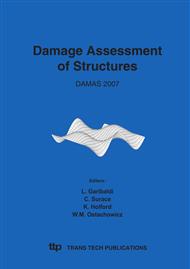p.311
p.317
p.323
p.331
p.339
p.345
p.351
p.359
p.365
Assessment of Damage Due to Earthquake-Induced Pounding between the Main Building and the Stairway Tower
Abstract:
The reports after earthquakes indicate that earthquake-induced pounding between insufficiently separated structures, or their parts, may cause substantial damage or even lead to structural collapse. One of the most spectacular example of pounding-involved destruction resulted from interactions between the Olive View Hospital main building and one of its independently standing stairway towers during the San Fernando earthquake of 1971. The aim of the present paper is to assess the range and intensity of damage caused by collisions between these reinforced concrete structures based on the results of a detailed 3D non-linear FEM analysis of poundinginvolved response. In the study, reinforced concrete has been modelled as layered material with rebar elements embedded into concrete. The non-linear material behaviour, including stiffness degradation of concrete due to damage under cyclic loading, has been incorporated in the numerical model. The results of the study show that pounding may lead to the significant increase of the range and intensity of damage at the base of the stairway tower, as a lighter structure, as well as may cause substantial damage at the points of contact. On the other hand, the intensity of damage induced in the heavier main building has been found to be nearly unaffected by structural interactions.
Info:
Periodical:
Pages:
339-344
Citation:
Online since:
September 2007
Authors:
Keywords:
Price:
Сopyright:
© 2007 Trans Tech Publications Ltd. All Rights Reserved
Share:
Citation:


